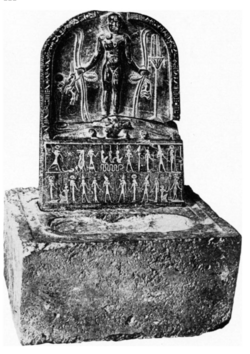Banobal inscription
Topic: Social
 From HandWiki - Reading time: 2 min
From HandWiki - Reading time: 2 min
The Banobal inscription is a Phoenician graffiti inscription on a block of marble which served as a base for an Egyptian stele, found near the Pyramid of Unas in Memphis, Egypt in 1900.[1] The inscription is known as KAI 48 or RES 1.
The inscription is the front of the plinth of the stele, which measures 55 x 64 x 32 cm. The text of the inscription is damaged; it has been dated to the 2nd-1st centuries BCE.[2]
It was first mentioned in 1900 by Melchior de Vogüe, who had been sent a copy of the stele by Gaston Maspero, who was excavating Memphis, Egypt.[3]
Charles Clermont-Ganneau suggested the name might be better restored Banoba'al or Hanobal.[4]
The inscription includes the name Banobal, which scholars connected to Banobali or Bariobali, a Phoenician temple slave described by Cicero in In Verrem.[5]
It is currently at the Egyptian Museum, with ID CG 9402 (JE 33264+34081).
References
- ↑ Lidzbarski, Mark, Le nom phenecien Banobal et l'inscription de Memphis., Ephemeris für semitische Epigraphik, volume I, p.285: "Diese Inschrift steht als Graffito auf einer äg3rptischen Opfer- tafel, die von Maspero in einem Schacht in der Nähe der Pyramide des Ünas gefunden wurde."
- ↑ Lidzbarski, Mark, Eine phönizische Inschrift aus Memphis, Ephemeris für semitische Epigraphik, volume I, p.152 ff: "Die Inschrift steht auf der Front des Sockek einer sehr schönen Stele, Horus auf den Krokodilen, jetzt gleichfalls im Gizehmuseum. Breite des Sockels: 55 cm., Tiefe: 64 cm., Höhe: 32 cm.... Die Inschrift ist sehr schlecht erhalten. Sie lässt sich zwar zum grössten Teil rekonstruieren, aber für einige Stellen ist mir bis jetzt Sicheres nicht gelungen. Das Alter würde ein Ägyptologe wohl nach der Stele und dem Fundorte feststellen können, doch kann man es auch aus der Inschrift mit einiger Bestinmitheit thun. Die Charaktere, besonders 1, H und \ haben eine frappante Ähnlichkeit mit denen der Kranzinschrift Diese aber stanmit aus dem Jahre 96 v. Chr., daher wird die Inschrift von Memphis dem 2 — 1. Jahrh. v. Chr. angehören."
- ↑ Melchior de Vogüe, Une inscription phénicienne d'Égypte, Comptes rendus des séances de l'Académie des Inscriptions et Belles-Lettres Année 1900 44-2 pp. 150-151: "L'inscription est gravée sur un bloc de marbre qui servait de socle à une stèle égyptienne sur laquelle M. Maspero se réserve de donner ultérieurement des explications. Le texte a malheureusement très souffert, et M. de Vogué croit prudent d'attendre, avant de risquer une interprétation définitive, la copie et les détails que M. Maspero annonce pour une prochaine expédition."
- ↑ Clermont-Ganneau, Charles, Le nom phénicien Banobal et l’inscription de Memphis, Recueil d'archéologie orientale, Volume IV, 1901, section 41, page 216-217
- ↑ Cicero, M.T.; Lambin, D.; de Saint-André, P. (1577) (in la). M. Tvllii Ciceronis opera omnia qvae exstant,. M. Tvllii Ciceronis opera omnia qvae exstant. Apud Petrum Santandreanum. p. Book III Chapter 39. https://books.google.com/books?id=-ZhoAAAAcAAJ&pg=RA2-PA134.
 KSF
KSF
